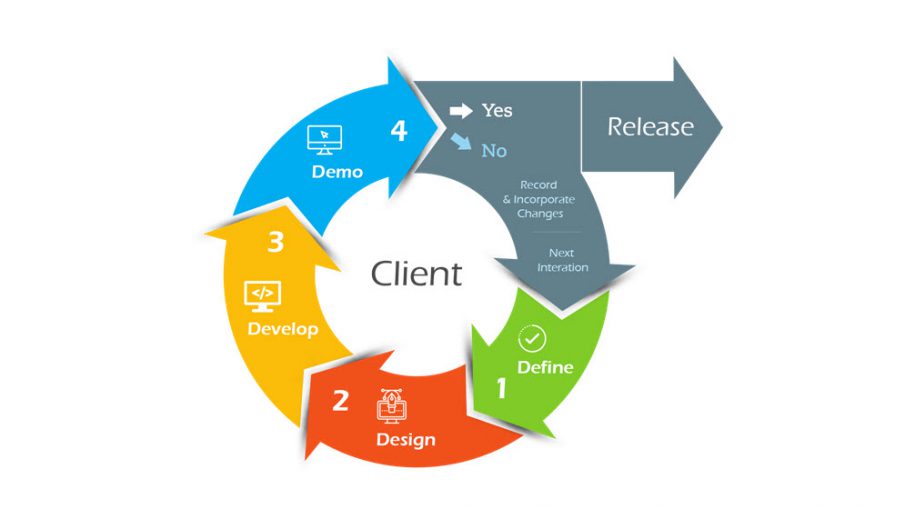What is Agile Methodology?
Agile methodology is an iterative and incremental approach to software development. Agility involves incremental builds presented in multiple iterations to stakeholders for feedback. Based on the feedback, changes are incorporated in the next iterations of the build on the basis of their priority. It is focused on delivering quality software quickly and is based on the seven lean principles; eliminate waste, amplify learning, decide late, deliver fast, empower the team, build integrity, and see the whole product.
Agile methodology is best known for its rejection of bureaucracy and is best suited for small teams working fast and operating with autonomy. Once you are able to examine the merits and disadvantages of Agile, you will be armed with all the information you need to select the best methodology for your team.
12 Key principles and advantages of Agile Methodology that make it flexible
For more information on the 12 principles of agile methodology and how they came about, please visit Principles behind the Agile Manifesto The Agile Methodology is categorized into a 12-part manifesto. These are principles that guide agile development. The principles emphasize Individuals and teams over processes and tools. Additionally, they encourage individuals and teams to work together in a self-organizing manner. The manifesto states: “We are working on a few simple principles: that the best way to do engineering is by working together in pairs, that communication is essential, that face-to-face collaboration is the best form of communication, and that working software over comprehensive documentation every day is the key to sustainable engineering.” The following are the 12 principles that give agile methodology an advantage over other methodologies.
1) Satisfy the customer early and continuous delivery
Instead of delivering complete software with all the features and functions in one go, the focus here is to divide and deliver functioning software into small parts, whereby each part/delivery focuses on a small but essential feature and functions that can be used after delivery.
2) Encourage changing requirements during collaboration with the customer
This principle allows the customer to make changes to the features and functions until the end of the project life cycle. This, unlike other approaches, allows the client to adjust the software’s features and functions and make necessary adjustments to gain a competitive advantage. This becomes very useful in long-running projects or when regulations or requirements are likely to change often.
3) Focus on frequent delivery from the very start of the project
This principle ensures the customer can provide input from the start of the project instead of waiting for months or, in some cases, years to see the final output. This ensures all stakeholders are kept up to date with the progress and able to adjust the requirements once they can see the output because of frequent delivery.
4) Encourage knowledge sharing and visibility between the business and development team
This principle allows the development and the business teams to work together to convert business requirements into modules, features and functions without the core requirements getting lost in translation.
5) Involve key stakeholders who are affected by a problem which the software will solve for them
This principle encourages the involvement of key stakeholders that will be directly impacted by the software which will be developed and used by them. This ensures the end users of the software get involved in the design and ensure what gets delivered is exactly what they need to solve a particular problem.
6) Encourage constant communication and sharing of thoughts
The agile methodology requires regular feedback and communication between all parties involved in the development process. This ensures everyone involved can share and validate their ideas and suggestions to improve the software constantly. Without this, the best ideas and suggestions can never see the light of day as it may be too late to accommodate them after a certain stage of the development process without costly and time-consuming redevelopment effort.
7) Focus on delivering working software quickly
This principle focuses on prioritising the delivery of working software over delaying the delivery for completeness. This ensures software is divided into small sprints and delivered quickly, allowing the customer to test and provide feedback from real-world use.
8) Encourage constant development and improvement without compromising on software quality
This principle ensures the business and software development team visualises the software project as every evolving asset capable of adapting to ever-changing business needs. This mindset allows the agile team to develop flexible and adaptable software which can be changed quickly to react to regulatory changes or to take a competitive advantage.
9) Focus on technical excellence and good design
This principle ensures each iteration or deliverable goes through the quality controls to ensure technical excellence and good design guides rather than waiting at the very end to perform these activities. It allows developers to clean the code at every iteration, resulting in software that functions as needed and ensures minimal maintenance and support.
10) Encourage to keep things simple
In the software development world, it is very easy to get bogged down in solving complex challenges and before you know it, one has invested weeks and months solving a not-so-important feature or function. This principle encourages all parties to keep things simple by breaking down complex requirements into small, manageable iterations.
11) Encourage self-organising and lack of micro-management
This principle encourages self-organisation in teams and allows them to prioritise the features and functions accordingly. The use of project management software helps the team keep track of all the work they have to perform and keeps the stakeholders informed of the timelines.
12) Fine-tune the process by making use of project management tools
This principle encourages the team to regularly inspect and reflect on the work and process to identify any scope for improvement and implement it as soon as possible. Using project management tools ensures the delivery from each team member is tracked against expected timescales and any areas of improvement or obstacles are identified as soon as possible.
Disadvantages of Agile development methodology

1) Lack of documentation
Because agile methodology relies on an iterative approach and focuses on delivering something that works, documentation is often considered a low priority. As evident from several studies, lack of documentation can prove very costly in the long run, especially for the new members of the team who join from the middle
2) Developer skill set and training
Agile development requires the development team to have certain soft skills to be able to liaise with the business team. Over the years, engineering courses and degrees that teach programming and computer science do not teach soft skills, which can become a problem since regular communication is key during Agile development.
3) Lack of planning and project management software
Agile methodology focuses on short delivery cycles rather than long-term vision and planning. This can result in difficulty for the management team in estimating when the final software system will be ready for production use, especially if the agile team is not using specialist agile project management software and tools.
4) Scope creep
Scope creep is fairly common during agile development because of loosely defined software requirements and high-level project delivery time scales.
5) Biting more than you can chew in one iteration
Taking more on the plate in one iteration can result in the agile team rushing to deliver the iteration and compromising on quality controls. Proper project management and quality controls are required to mitigate these risks.
When should you use the Agile project management methodology?
The answer depends upon many factors such as the type of project, complicity, delivery timescales and ability to divide the project into phases. Generally, agile development methodology should only be undertaken with a seasoned team with experience and specialist training in the same.

